Please email me at:
Or use the form below.
[contact-form 1 “Contact form 1”]
The no-pants guide to spending, saving, and thriving in the real world.

Last night, a friend called me up and asked me to accompany him to the police station. The police had knocked on his door, waking up his girlfriend while he was out. When he called, they wouldn’t tell him why they wanted to talk to him. Was it an ex trying to make his life difficult or one of his employees getting investigated?
This friend has had a number of interactions with the police, but never learned how to deal with them. Before we left, I gave him a crash course in “stay out of jail”.
During an investigation, you are a suspect. They are looking for a conviction. There may be a “good cop” trying to “help you out”, but he is trying to put you in jail. “Protect and Serve” doesn’t mean you. In general, it means society as a whole. During an investigation, they are serving the interests of the prosecutor.
Generally, they are going to look at you–as the target of their investigation–as the enemy. This is normal. They spend all of their time dealing with scumbags and s***heads. Naturally, they start to assume that everyone who isn’t a cop will fall into one of those categories.
Don’t get pissed when they act rude, ignore you, or anything else. It isn’t a lack of professionalism, it’s just a different profession. They are using interrogation techniques that have been proven successful. Ignore it and focus on Lesson 2.
It will feel wrong to disobey the authority you’ve been taught your entire life to obey. You’re not. You are standing by your rights. Nobody cares about your future more than you do. Certainly not the guy investigating you.
The second a police interaction starts to look like they are investigating you, demand your lawyer, then see Lesson 4. When you demand an attorney, they stop asking you questions. You can take it back and start talking, so again, see Lesson 4. It’s your attorney’s job to talk to the police and, if necessary, the media. It’s your job to talk to your attorney.
You don’t need an attorney ahead of time. Criminal defense attorneys are used to getting calls at 3AM. It’s part of their job. If you have a low enough income as defined by whatever jurisdiction you are being investigated in, you can get a public defender. That’s better than nothing, but I’d prefer to hire a professional shark, even if it means mortgaging my future. Prison is a big gamble.
The right of the people to be secure in their persons, houses, papers, and effects, against unreasonable searches and seizures, shall not be violated, and no Warrants shall issue, but upon probable cause, supported by Oath or affirmation, and particularly describing the place to be searched, and the persons or things to be seized.
“Officer, I do not consent to any search and I would like to speak to my attorney.” Remember this. Memorize it.
They need probable cause, a warrant, or permission to search your stuff. Never agree to it. Don’t stop them if they search anyway, but never, ever agree to a search. If the search is done improperly, your lawyer(see Lesson 2) will get the results of that searched thrown out.
It isn’t possible to get into more trouble for standing by your rights. There is no crime on the books anywhere in the US called “Refused Consent to Search”. Your day will not go worse because you defended your Constitutional rights.
I know a few defense attorneys. According to them, most of the people in jail either committed a crime in front of a bunch of witnesses, or they talked their way into jail. Shut up. You’ll want to either justify or defend yourself depending on the circumstances. Don’t. Shut up. It may be one of the hardest things you ever do, but keep your mouth closed. The only thing worse than talking is lying. Don’t lie, just keep quiet.
There is nothing you are going to say that will make your interrogator invite you home for Christmas. He isn’t your friend, you won’t meet his parents, you aren’t going to his birthday party. There is absolutely no win in talking to him. Shut up. The answer to every question is “Lawyer.” If the only thing you say babble is “Lawyerlawyerlawyerlawyerlawyerlawyer”, you’re probably not going to do too badly.
In your car, the dynamic changes a bit, but the principles don’t. When a cop pulls you over, don’t argue. You can’t win an argument with a cop on the side of the road. Be nice, be polite, and as soon as possible, pull into a parking lot and take as many notes about the encounter as you can. If you are planning to fight whatever he pulled you over for, don’t give him any reason to remember you or spin his official report to make you look bad. Again, shut up. Catching a theme?
If you are being investigated by the police, your future–or some part of it–is on the line. While you are gambling with your criminal record and your freedom, don’t forget that you are an amateur in this arena. The police, the prosecutor, and your attorney are the professionals and the stakes can be huge. Keep your mouth shut, call your attorney, and thank me later.
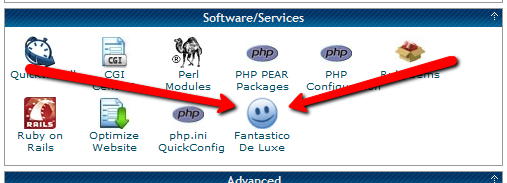
In this installment of the Make Extra Money series, I’m going to show you how to set up a WordPress site. I’m going to show you exactly what settings, plugins, and themes I use. I’m not going to get into writing posts today. That will be next time.
I use WordPress because it makes it easy to develop good-looking sites quickly. You don’t have to know html or any programming. I will be walking through the exact process using Hostgator, but most hosting plans use CPanel, so the instructions will be close. If not, just follow WordPress’s 5 minute installation guide.
Assuming you can follow along with me, log in to your hosting account and find the section of your control panel labeled “Software/Service”. Click “Fantastico De Luxe”.

On the Fantastico screen, click WordPress, then “New Installation”.
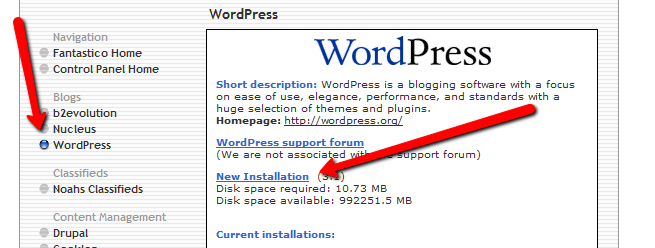
On the next screen, select your domain name, then enter all of the details: admin username, password, site name, and site description. If you’ll remember, I bought the domain http://www.masterweddingplanning.net. I chose the site name of “Master Wedding Planning” and a description of “Everything You Need to Know to Plan Your Wedding”.
Click “install”, then “finish installation”. The final screen will contain a link to the admin page, in this case, masterweddingplanning.net/wp-admin. Go there and log in.
After you log in, if there is a message at the top of the screen telling you to update, do so. Keeping your site updated is the best way to avoid getting hacked. Click “Please update now” then “Update automatically”. Don’t worry about backing up, yet. We haven’t done anything worth saving.
Next, click “Settings” on the left. Under General Settings, put the www in the WordPress and site URLs. Click save, then log back in.
Click Posts, then Categories. Under “Add New Category”, create one called “Misc” and click save.
Click Appearance. This brings you to the themes page. Click “Install Themes” and search for one you like. I normally use Headway, but before I bought that, I used SimpleX almost exclusively. Your goal is to have a simple theme that’s easy to maintain and easy to read. Bells and whistles are a distraction.
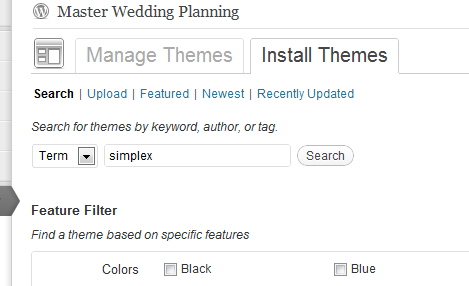
Click “Install”, “Install now”, and “Activate”. You now have a very basic WordPress site.
A plugin is an independent piece of software to make independent bits of WordPress magic happen. To install the perfect set of plugins, click Plugins on the left. Delete “Hello Dolly”, then click “Add new”.
In the search box, enter “plugin central” and click “Search plugins”. Plugin Central should be the first plugin in the list, so click “install”, then “ok”, then “activate plugin”. Congratulations, you’ve just installed your first plugin.
Now, on the left, you’ll see “Plugin Central” under Plugins. Click it. In the Easy Plugin Installation box, copy and paste the following:
All in One SEO Pack Contact Form 7 WordPress Database Backup SEO SearchTerms Tagging 2 WP Super Cache Conditional CAPTCHA for WordPress date exclusion seo WP Policies Pretty Link Lite google xml sitemaps Jetpack by WordPress.com
Click “install”.
On the left, click “Installed Plugins”. On the next screen, click the box next to “Plugins”, then select “Activate” from the dropdown and click apply.
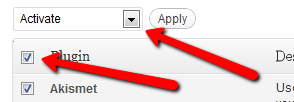
Still under Plugins, click “Akismet Configuration”. Enter your API key and hit “update options”. You probably don’t have one, so click “get your key”.
The only tool I worry about is the backup. It’s super-easy to set up. Click “Tools”, then “Backup”. 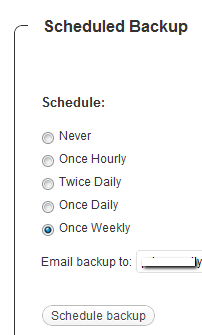
Scroll down to “Schedule Backups”, select weekly, make sure it’s set to a good email address and click “Schedule Backup”. I only save weekly because we won’t be adding daily content. Weekly is safe enough, without filling up your email inbox.
There are a lot of settings we’re going to set. This is going to make the site more usable and help the search engines find your site. We’re going to go right down the list. If you see a section that I don’t mention, it’s because the defaults are good enough.
Set the Default Post Category to “Misc”.
Visit this page and copy the entire list into “Update Service” box. This will make the site ping a few dozen services every time you publish a post. It’s a fast way to get each post indexed by Google.
Click “Save Changes”.
Uncheck everything under “Email me whenever…” and hit save. This lets people submit comments, without actually posting the comments or emailing me when they do so. Every once in a while, I go manually approve the comments, but I don’t make it a priority.
Select “Custom structure” and enter this: /%postname%/
Click save.
Set the status to “Enabled”, then fill out the site title and description. Keep the description to about 160 characters. This is what builds the blurb that shows up by the link when you site shows up in Google’s results.
Check the boxes for “Use categories for META keywords” and “Use noindex for tag archives”.
Click “Update Options”.
Check the boxes to remove each of the dates and set the alt text to “purpose” or something. This will suppress the date so your posts won’t look obsolete.
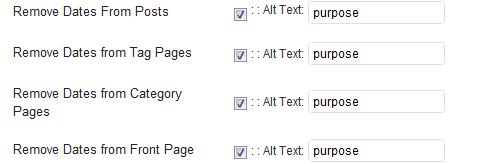
This plugin reinforces the searches that bring people to your site. It’s kind of neat. Skip the registration, accept the defaults and hit save.
Scroll to the bottom and click import. We’ll come back to this.
Select “Caching On” and hit save.
Across the top of the screen should be a giant banner telling you to connect to WordPress.com and set up Jetpack. You’ll need an account on WordPress.com, so go there and set one up. After authorizing the site, you’ll be brought back to the Jetpack configuration screen. Click “Configure” under “WordPress.com Stats”. Take the defaults and hit save.
On the contact configuration page, copy the code in the top section. You’ll need this in a moment.
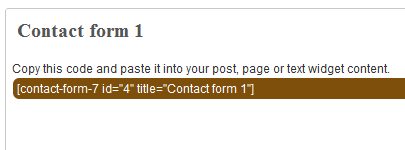
Now, we going to create a couple of static pages. On the left, click “Pages”, then “Add new”.
Name the first page “Contact” and put the contact form code in the body of the page. Hit publish.
Under Appearance, click “Menu”. Enter a menu name and hit save.
Then, under “Pages”, click the box next to “Contact”, “Disclaimer”, and any other policies you’d like to display. Hit save.
Also under Appearance, click “Widgets”. This is where you’ll select what will display in the sidebar. All you have to do is drag the boxes you want from the middle of the page to the widget bar on the right. I recommend Text, Search, Recent Posts, Popular Search Terms and Tag Cloud. In the text box, just put some placeholder text in it, like “Product will go here”. We’ll address this next time.
We’re not going to worry about getting posts in place, yet. That will be the next installment. However, the steps in the next installment could take 2 weeks to implement, and we want Google to start paying attention now. To make that happen, we need to get a little bit of content in place. This won’t be permanent content. It’s only there so Google has something to see when it comes crawling.
To get this temporary, yet legal content, I use eZineArticles. Just go search for something in your niche that doesn’t look too spammy.
Then, click “Posts”, then delete the “Hello World” post. Click “Add new”. Copy the eZine article, being sure to include the author box at the bottom, and hit publish.
To see your changes, you may have to go to Settings, then WP Cache and delete the cache so your site will refresh.
Congratulations! You now have a niche blog with content. It’s not ready to make you any money, yet, but it is ready for Google to start paying attention. In the next installment, I’ll show you how I get real unique content and set it up so Google keeps coming back to show me the love.
Today, I continuing the series, Money Problems: 30 Days to Perfect Finances. The series will consist of 30 things you can do in one setting to perfect your finances. It’s not a system to magically make your debt disappear. Instead, it is a path to understanding where you are, where you want to be, and–most importantly–how to bridge the gap.
I’m not running the series in 30 consecutive days. That’s not my schedule. Also, I think that talking about the same thing for 30 days straight will bore both of us. Instead, it will run roughly once a week. To make sure you don’t miss a post, please take a moment to subscribe, either by email or rss.
This is day 4 and today, you are going to make a budget.
Now that you’ve got your list of expenses and you’ve figured out your income, it’s time to put them together and do the dreaded deed. Your going to make a budget today. Don’t be scared. I’ll hold your hand.
Here are the tools you need:
Setting up the spreadsheet is dead simple.
Create a column for the label, telling you what each line item is. Create a column to hold the monthly payment amount. At the bottom of column 2, create a formula that totals your expenses. If you are including a bill that isn’t due monthly, use a formula similar to the day 3 income formula to figure out what you need to set aside each month. To figure a quarterly bill, multiply the amount by 4, then divide by 12. To figure a weekly bill, multiply by 52 and divide by 12.
Scoot over a few columns and do the same thing for your income.
Scoot over a couple more columns and set up a total. This is easy. It’s just a matter of subtracting your expenses from you income. Hopefully, this gives you a positive number.
To make this even easier, I’ve shared a blank budget spreadsheet. No excuses. If that simple spreadsheet doesn’t meet your needs, I’ve got a much more detailed version that includes categories. I use the detailed version.
Making a budget may be the most intimidating financial step you take, but everything else is built on the assumption that you understand where you money came from and where it is going. Without,it, your navigating a major maze based on a coin flip instead of a map.
I keep calling these lessons, but they are examples and explanations, more than lessons. Names aside, please see Part 1 and Part 2 to catch up. The Google Doc of this example is here.

This time, I’m going to review my non-monthly bills. These are the bills that have to be paid, but not on a monthly basis. Some are annual, others are quarterly, or even weekly. Every month, the amount–adjusted to the monthly equivalent–is set aside in Quicken.
There aren’t too many items here that can be legitimately and responsibly trimmed.

This is a guest post.
Life cover insurance acts as a safety net to pay for a family’s expenses should a wage earner become critically ill or die prematurely. Life cover includes life insurance as well as disability, critical illness, mortgage and income protection insurance policies.
In most families, at least one adult is a wage earner and uses their income to pay for necessities such as food, clothing and rent or mortgage. If the wage earner becomes disabled, too ill to work, or dies, life cover insurance can pay for these expenses.
Stay-at-home parents provide valuable, though unpaid, services to the family. Without that person, the family would have to pay for childcare, household upkeep, errand running, and every other chore the stay-at-home parent did. If the stay-at-home parent has life insurance, these expenses can be covered.
Life cover insurance can pay off mortgages and education loans.
Live cover insurance policies will pay funeral costs, which can be substantial.
Family owned businesses can be insured and protected if the owner dies.
Life cover insurance is too expensive.
Insurance companies have plans to suit every budget and life circumstance. While young and healthy adults will generally receive the most affordable policies, older adults have plenty of reasonably priced options as well.
Disability or severe illness is unlikely.
Actually, 32% of men and 25% of women, ages 40 to 70, will experience a critical illness or disability. http://www.healthinsuranceguide.co.uk/statistics_mainbody.asp
Discussing disability or death is awkward and uncomfortable.
Agreed, but avoiding the topic puts loved ones into economic jeopardy. Without the wage earner’s life cover, a family could lose their home and have to lower their standard of living.
Life Insurance
Term insurance is a protection policy, paid for during a specific time period (term), and is active during that time only. Permanent, whole, variable, universal and universal variable life insurance policies all are investment policies. They combine a death benefit (the amount paid out when the insured person dies) with an investment account. Licensed and experienced life insurance agents can help individuals make the best choice for their life situation.
Critical Illness/Disability Insurance
This type of insurance pays for living expenses if a person is diagnosed with a serious illness or disabled and can no longer work.
Mortgage Insurance
This is paid when the mortgage owner dies. This could help prevent the surviving family from having to sell the home.
The time to buy life cover insurance is now!
A 2010 survey (http://www.prnewswire.com/news-releases/ownership-of-individual-life-insurance-falls-to-50-year-low-limra-reports-101789323.html) stated that individual life insurance ownership was at a 50 year low in the United States. An estimated 35 million (30% of households) Americans do not have life insurance, and 11 million of these households have children under 18. Already living paycheck to paycheck, any debilitating injury or death of a wage earning adult could spell financial disaster to the family. Buying life cover insurance is a vital part of caring for loved ones. Just as a wage earner provides a home, food and daily necessities for their family, life cover insurance can take over and provide for the family if the wage earner unable to do so.